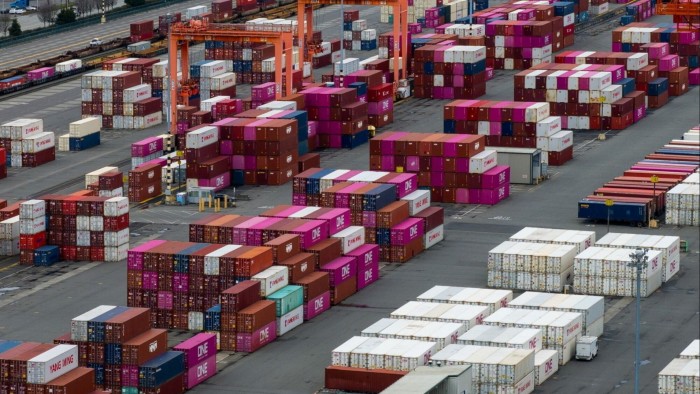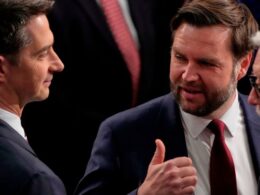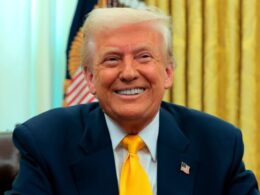The US’s “liberation day” approaches, and Goldman Sachs sees a greater chance the country is . . . freed . . . from economic expansion this year.
Jan Hatzius and the bank’s economists are raising their predicted likelihood of a recession this year, along with their forecasts for the ultimate amount of tariffs levied by the US, according to a note that made the rounds on Sunday.
Now, in more normal times, it’d be tempting to compare the US’s tariff headlines to the “guidance game” that public companies like to play ahead of earnings.
Ahead of companies’ quarterly results, Wall Street analysts slowly cut their forecasts, usually without any public statement from the company. And then — what do you know? — the company’s report beats “Wall Street expectations”. It’s not especially unusual for 70 per cent of companies in the S&P 500 to beat estimates.
But these aren’t normal times.
And while the US’s tariffs news could qualify as expectation management, it has not been subtle. Over the past week, we’ve heard:
1) The US will impose “reciprocal” tariffs but even worse, because they’ll count things like value-added taxes, which are not tariffs.
2) Just kidding, the US will “probably be more lenient” on tariffs, focusing them on its biggest 15 trading partners (most of its trade, but whatever).
3) Never mind, the US wants to impose 20-per-cent tariffs every country in the world.
4) And it’ll collect . . . $6tn doing it? What?
Anyway, whatever happens, President Donald Trump is calling the April 2 announcement “Liberation Day”, a catchily bizarre phrase.
Like a company heading into a bumpy earnings season, Wall Street seems to have gotten a steer too. It translates to “more tariffs than we thought there’d be a few months ago”.
On Sunday, Jan Hatzius and his GS economics team ratcheted up the bank’s tariff forecast. They now expect a 15-percentage-point increase in 2025:
For the second time in less than a month, we are raising our tariff assumptions. We now expect the average US tariff rate to rise 15pp in 2025 — our previous “risk case” and 5pp more than our previous baseline. Almost the entire revision reflects a more aggressive assumption for “reciprocal” tariffs. We expect President Trump to announce reciprocal tariffs that average 15% across all US trading partners on April 2, although we expect product and country exclusions to ultimately whittle the addition to the average US tariff rate down to 9pp.
The bank’s equity strategists now predict another 5 per cent decline in the S&P 500 over the next three months, followed by a mild rebound to leave it 6 per cent higher a year from now. They give the following reasoning:
Slowing growth and rising uncertainty warrant a higher equity risk premium and lower valuation multiples for equities. The S&P 500 entered 2025 trading at a 21.5x P/E multiple on consensus forward EPS, and currently trades at a multiple of 20x. With little change to consensus EPS estimates, all of the 9% sell-off from the market peak in February has stemmed from valuation contraction. We expect a further valuation decline in the near-term, with the P/E registering 19x in 3 months and rising modestly to 19.5x in 12 months.
And finally, Hatzius & Co raise their predicted recession likelihood to . . . 35 per cent. More on that in a second, once we see their reasoning behind this change:
[a] lower growth baseline, the sharp recent deterioration in household and business confidence, and statements from White House officials indicating greater willingness to tolerate near-term economic weakness in pursuit of their policies. While sentiment has been a poor predictor of activity over the last few years, we are less dismissive of the recent decline because economic fundamentals are not as strong as in prior years. Most importantly, real income growth has already slowed sharply and we expect it to average only 1.4% this year.
Now, 35 per cent doesn’t sound especially bold. It doesn’t even meet the Perkins Rule, named for TS Lombard’s Dario Perkins: You can predict basically anything, as long as you assign it a 40 per cent likelihood.
But it is rather interesting to see Government Goldman Sachs stick their neck out while writing from an American jurisdiction. It’s also unclear whether they’re following our Recession Watch.
Anyway! The bank’s economists now expect three Fed rate cuts as “insurance” this year, in the style of Powell’s 2019 shift:
We have pulled the lone 2026 cut in our Fed forecast forward into 2025 and now expect three consecutive cuts this year in July, September, and November, which would leave our terminal rate forecast unchanged at 3.5-3.75%. The downside risks to the economy from tariffs have increased the likelihood of a package of 2019-style “insurance” cuts, which we now see as the modal outcome under our revised economic forecast. While the Fed leadership has downplayed the rise in inflation expectations so far, we think it does raise the bar for rate cuts and in particular puts greater emphasis on a potential increase in the unemployment rate as a justification for cuts.
But in 2019, there wasn’t comparable inflation in basics like eggs, or a series of inflation-fuelling tariffs expected to go into place. (The bank does expect tariffs to boost inflation by half a percentage point, to 3.5 per cent PCE YoY.) So we’ll see.
Over at Barclays, the strategists are taking a broader world-historical view:
We think the direction of travel is clear: average tariff rates are increasing, likely to levels not seen since before World War II. At the end of 2024, the US weighted average tariff rate was 2.5%. After the tariffs that Trump has implemented so far, the average tariff rate has increased more than 3 times to over 8%. We assume once Trump is finished, it could be as high as 15%.
It’s worth noting that the 15 percentage point figure was cited by GS as well, though GS expects tariffs to increase by 15 percentage points, while Barclays expects them to end at 15 per cent.
Others at the British bank are finding their solace in literature. Barclays’ FICC team comes out with a more tormented take:
‘Love is a reciprocal torture’ lamented Marcel Proust, reflecting on the inherent suffering in romantic relationships. Donald Trump has the US’s suffering in foreign trade relationships in mind when introducing reciprocal tariffs next week, in addition to a 25% tariff on cars already announced this week. In his view, the US has ‘been ripped off for decades by nearly every country in the world’, which reciprocal tariffs will now rectify.
But just as with Proust’s love, Trump’s tariffs may also end in reciprocal torture because they risk hurting not only foreign exporters, but also domestic producers and consumers. The drop in confidence reflected in surveys and the sell-off in equities and risky assets more generally suggest that this is what consumers and investors fear.
Torture indeed!
Source link









